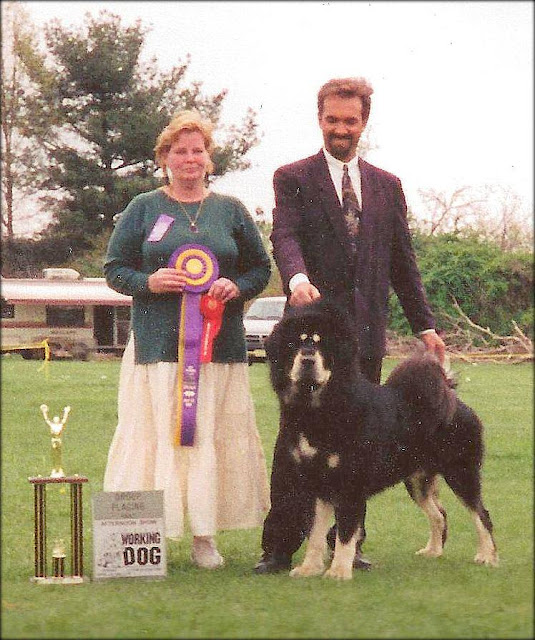ΑναβιΩνοντας τη μνΗμη ενοσ συμβολου των Tibetan mastiff
(24 Feb 1977 - 9 May 1987)
Η λογική με την οποία απονέμεται αθανασία δεν ειναι μία ούτε σε σκύλους ούτε σε ανθρώπους, ωστόσο σε πολλές μολοσοειδη- μαστιφοειδη φυλές, there are touchstone dogs who died decades, even centuries ago, who are nonetheless remembered today. Caligola (arguably a shade hypertypical, he nonetheless propelled Neapolitan Mastiffs onto the international stage, going Best in Show at the World Show in 1992), Thorneywood Terror (an early Bullmastiff type who never lost the challenge of bringing down a man in Victorian gamekeeper trials), Crown Prince (who gave 19th-Century Mastiffs their type and, some argue, took away their soundness in the bargain) – all are remembered in the collective consciousness of their respected breeds.
But what of Tü-Bo?
Το 1977, this Nepalese-bred German import was one of the first of his breed to arrive in modern Europe, along with four dogs from India that went to Holland. With the Tibetan plateau sealed behind the Red Curtain, Western breeders made do with lesser imports from India and the southern Himalayas, many of which stretched credulity as far as their purebred status was concerned. Several “types” of Tibetan Mastiffs were promoted as the ideal during that period. But Tü-Bo, with his exceptional construction and strong type, soon became the paradigm for the Tibetan Mastiff in Europe and beyond.
Tü-Bo sired some of the first litters in Europe – two in the Netherlands and one in his adopted home of Germany. It was with this last litter, out of Langtang Shu-Khen Chung, an American export bred by Anne Rohrer, who had established the first American breeding program several years earlier, that Tü-Bo cemented his legacy. Two of his sons from that breeding – Yi-Dam Amban and in particular Yi-Dam Akbar – were widely used, ensuring that Tü-Bo appeared in nearly all subsequent European pedigrees.
As successful in the show ring as he was the whelping box, Tü-Bo won the breed at the World Dog Shows in 1979, 1980 and 1981.
Tü-Bo soon become “the symbol of European breeding,” wrote Molosser Magazin publisher Christofer Habig in the January 1985 issue devoted to the Tibetan Mastiff, with Tü-Bo on the cover, calling him an “important transmitter” of type and a “guiding line” for breeders in Europe, where he had “earned himself the central place in the youngest history of the Tibetan Mastiff.”
Today, however, the situation could not be any more different.
“No, Tü-Bo is forgotten,” Habig says. “As there has been so little ‘esprit de corps’ among Tibetan Mastiff folks during the last twenty-odd years, there are no common values, nor common heroes left.”

Tü-Bo, arguably the finest Tibetan Mastiff imported into Europe during the breed’s modern reintroduction there, from the cover of the January 1985 Molosser Magazin.
A quarter-century ago, Habig was writing about the need for Tibetan Mastiff breeders to focus on a common goal, a unified vision of the breed. He says breeders have forgotten about Tü-Bo – who was a fine example of the more moderate Do-Khyi type of Tibetan Mastiff – precisely because they are caught up in these complex issues of breed identity. “Currently, the ‘vacuum’ which FCI has created due to not solving the issue of Do-Khyi versus Zang Ao” – another term for the Tsang-Khyi, or larger, more Molosser-type dog – “seems to dominate the conflict between the various camps.”
“Maybe it is because I am now removed from regular involvement with the breed, but I sense from talking with those who are still active within it that Tü-Bo is no longer of relevance to the breed today,” says Eric Holliday of Chortens Tibetan Mastiffs in the United Kingdom. “More interest seems to be spent on considering the rights and wrongs of Chinese-type dogs and other imports worldwide.”
Richard Eichhorn of Drakyi Tibetan Mastiffs in California remembers visiting Tu-Bo at the home of his first owner, Herr Boese, in the mid-1980s – a trip he likened to visiting Mecca for a serious Tibetan Mastiff enthusiast of the time.
“We went into the house and Tü-Bo was very accepting of me, came right up to me, looked me in the eye, and allowed me to pet him,” says Eichhorn, who later imported three Tü-Bo puppies, the result of an inbreeding to his daughter Yi-Dam Aksu. “It was just a thrill to see this foundational dog.”

This side profile of Tü-Bo underscores the soundness and type that made him a sought-after stud dog.
Tü-Bo was a blue-and-tan, which was very rare for the time, and the preponderance of that pattern in European dogs today is a vestige of his early influence. But looking beyond color, Eichhorn was struck by Tü-Bo’s sheer quality.
“He was very typical, in his head shape, his body, his coat texture, and very correct in his proportions,” Eichhorn remembers. “He was probably only 68.5-70cm, but he was of the mastiff type – he had the characteristic mane, and his bone was proportionate to his body. I could see why he had such a great influence in the early breeding programs.”
So perhaps today it is more important than ever to resurrect the memory of Tü-Bo, if only to remind feuding Tibetan Mastiff fanciers that a middle ground is indeed attainable – that a dog need not be overdone to be typey, nor common looking in order to be moderate. And that quality, as Tü-Bo’s pictures show, really is timeless.











